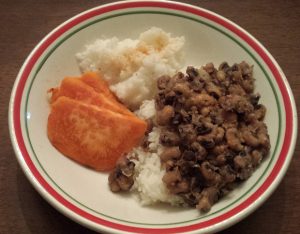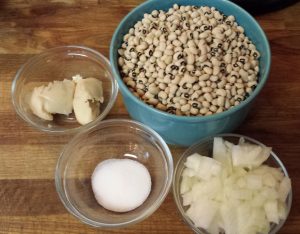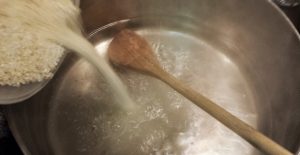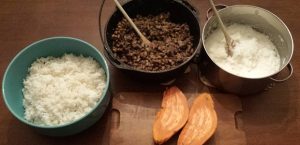While it is a shameful chapter in our national past, the fact of slavery during the Revolutionary Era is inescapable, and part of understanding how the people of this nascent country ate is exploring how the slaves were fed. Sources are exceptionally scarce and contemporary recipes are nonexistent, but we can reconstruct some idea of what the table in the slaves’ quarters might have offered to maintain these unfortunate souls in their labors.
Most sources agree that the slaves were generally expected to get by on what was left from the slaveholders’ larders, supplemented with what they could raise on their own, provided that their owners permitted it. What documentation exists of what rations slaveholders provided is typically from later periods, but it would be in their own interest to ensure that their labor force was well-nourished enough to work effectively.
The cooking traditions of the slaves were, as with most newcomers to these shores, a creative amalgamation of what they knew from their homelands and what was available to them here. We’ll cook three representative dishes, each of which can help us understand a slightly different aspect of the food experiences of the Revolutionary Era slave.
Black-Eyed Peas and Rice
Though the modern dish of the Carolinas, Hoppin’ John, was not described in print until the publication in 1847 of Sarah Rutledge’s Carolina Housewife[i], its roots are believed to lie in the Senegalese dish, thiébou niébé[ii]. Black-eyed peas were introduced in the Americas around the middle of the 18th century, and were noted in some of Washington’s writings and other contemporary sources.
However, because the availability of ham and even bell peppers, typical of the later dish, would likely have been limited, we’ve stuck with a much more limited selection of ingredients for our recipe. Bacon grease or other pork fat would have been relatively easy to come by, and if chicken stock weren’t available on a given day, this recipe would still work, with the addition of some extra salt. Onions could be grown in the yard, alongside the black-eyed peas.
Heat in a Dutch oven or other large pot with a cover:
2 tbsp (30 ml) bacon fat
Sautée until soft:
1 onion, diced
Add:
6 cups (1 1/4 liter) chicken stock
1/2 tsp (3 ml) salt
4 cups (900 ml) black-eyed peas
Bring to a boil, lower the heat to a simmer, cover and simmer, stirring occasionally to prevent it from scorching, until peas are tender (30 minutes to an hour if using fresh or frozen peas; up to two hours for dry).
Serve with plain white rice, perhaps cooked with a little extra water, so that it softens a bit more than usual, and if you have it, dash some pepper sauce over it to liven up the flavor.
Baked Sweet Potato
Root crops figure heavily in modern African cuisine, and yams were likely well-known in the cultures from which American slaves were taken. The sweet potato, indigenous to North America, is quite similar in texture and appearance (to the point that many modern cooks have trouble distinguishing them), and it’s believed that slaves simply used them just as they had yams in Africa.[iii]
Again, simple preparation is likely to be the most authentic, and interviews with slaves of later periods[iv] indicate that they would simply wrap the sweet potatoes in leaves, place them in the coals and let them roast. We’ll substitute aluminum foil and an oven.
Preheat oven to 400° F (200° C). Wrap in foil:
One or more sweet potatoes or yams
Place on a roasting pan, and bake until soft, perhaps an hour or two, depending upon the size of your sweet potato. A sure indicator that they’re done is that they start to leak caramelized sugars into the pan.
Cool enough to handle, and then peel the skins off and discard. Serve in slices, or mash it up with a little salt.
Hominy Grits
Grits are today considered a staple of the “Southern” diet, but they were, in fact, a classic merger of the Old World and the New. The process for converting plain corn to the more-digestible hominy, which involves soaking in lye (extracted from ashes), was taught to the earliest settlers by the Native Americans.
Boiling ground grains into a porridge called polenta was a longtime Roman and Italian practice, which they quickly adapted to corn when that originally came over from America. It was only a matter of time before hominy was ground and boiled, and the result became an easy (and cheap) food to sustain both slaves and slaveholders. Both unprocessed and processed corn was used, but we’ll go with the hominy version of it for our recipe.
We should acknowledge, too, that the corn and rice would not likely have appeared on the same plate together. Most slaves were fed heavily on corn, and there were just a few areas in the new nation where rice was so plentiful that it supplanted corn in their diets. However, the historical roots of both dishes have so much to teach us about the slave experience that it’s worth including them together here.
Grits purists will be gratified to hear that, again, we will take a very straightforward approach to this dish, eschewing cheese, ham or other additions or embellishments.
In a large pot, bring to a boil:
6 cups (1.25 liter) water
1 tsp (5 ml) salt
Add, stirring constantly:
2 cups (450 ml) grits (regular, not instant)
Reduce heat to a low simmer and cook for five minutes, stirring occasionally. Serve immediately, with pepper sauce if desired.















4 Comments
Nice recipes. They may well have also added greens like collards, but this is really quite a nourishing meal.
I did find references to collard greens and cabbage in the course of my research, yes.
Of course, nobody at that time had any sense of vitamins or trace minerals, but some cookbooks of the period do have lengthy discourses on the importance of balance of different sorts in one’s diet. Collards would probably be classed as cool and dry, and would nicely balance the warm and wet nature of the rice and beans.
Just found your series! Fantastic work and writing. Looking forward to trying out all the recipes.
Thank you very much!! These have been a great deal of fun to work on, and I love getting feedback from readers. Do let me know what you think of the recipes that you try.